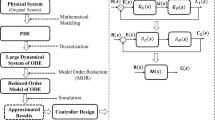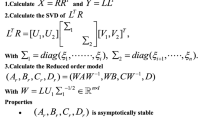Abstract
For the purposes of representing the characteristics of physical systems, the LTI (Linear Time Invariant) models are often used. Even in the case where the physical system is described by a set of nonlinear differential equations, the linearization process is able to determine a set of linear differential equations e.g. at the working point. The main problem that arises when designing the system model is the order of the resulting matrices. The model order reduction of the LTI models is a common operation which led to obtain a model of smaller size. The large system size issue often make impossible to perform real-time simulation or designate the control system - for example, determining the LQG control system is possible only for relatively small models. In order to achieve high accuracy of the reduced model with the original model, it is necessary to perform a reduction in the specified range of frequency. The problem arises when the resulting model has to match both - low and high frequencies. In addition, models that describe the slow and fast phenomenon are difficult to numerical analyze. The authors propose the use of a methodology, which bases on separating the model into two parts - the fast part and the slow part. The modified Epsilon decomposition is proposed do achieve this goal. The obtained results confirm that the presented methodology is correct.
Access this chapter
Tax calculation will be finalised at checkout
Purchases are for personal use only
Similar content being viewed by others
References
Enns, D.: Model reduction with balanced realizations: an error bound and a frequency weighted generalization. In: Proceedings of the 23rd IEEE Conference on Decision and Control, Las Vegas, pp. 127–133 (1984)
Lin, C., Chiu, T.: Model reduction via frequency weighted balanced realization. Control Theory Adv. Technol. 8, 341–451 (1992)
Heck, B., Haddad, A.: Singular perturbation in piecewise - linear systems. IEEE Trans. Autom. Control 34, 87–90 (1989)
Naidu, D., Price, D.: Singular perturbations and time scale in the design of digital flight control systems. NASA Technical Paper 2844 (1988)
Kokotovic, P., Khalil, H., O’Reilly, J.: Singular Perturbations Method in Control: Analysis and Design. Academic Press, London (1986)
Zečević, A., Šiljak, D.: Control of Complex Systems. Structural Constraints and Uncertainty. Springer, London (2010)
Šiljak, D.: Decentralized Control of Complex Systems. Academic Press, New York (1991)
Sezer, M., Šiljak, D.: Nested epsilon decompositions of linear systems: weakly coupled and overlapping blocks. SIAM. J. Matrix Anal. Appl. 12(3), 521–533 (1991)
Sezer, M., Šiljak, D.: Nested ε decompositions and clustering of complex systems. Automatica 22, 321–331 (1986)
Miljkovic, D.: https://sourceforge.net/projects/epsd/files/latest/download. Accessed 16 July 2017
Stanisławski, W.: Modelowanie i symulacja komputerowa parowników przepływowych kotłów energetycznych [Modeling and computer simulation of flow evaporators of power boilers], Studia i Monografie, z. 124, Oficyna Wydawnicza Politechniki Opolskiej, Opole (2001)
Rydel, M.: Zredukowane hierarchiczne modele złożonych obiektów sterowania na przykładzie kotła energetycznego [Hierarchical reduced models of complex control objects on the example of the power boiler], Ph.D. thesis, Faculty of Electrical Engineering, Automatic Control and Informatics, Opole University of Technology, Opole (2008)
Raczyński, D.: Redukcja modeli obiektów sterowania z zastosowaniem obliczeń równoległych na przykładzie modelu kotła energetycznego [Model order reduction of control systems with use fo the parallel computing on example of the power boiler], Ph.D. thesis, Faculty of Electrical Engineering, Automatic Control and Informatics, Opole University of Technology, Opole (2014)
Author information
Authors and Affiliations
Corresponding author
Editor information
Editors and Affiliations
Rights and permissions
Copyright information
© 2018 Springer International Publishing AG
About this paper
Cite this paper
Raczyński, D., Stanisławski, W. (2018). Use of the Modified EPSILON Decomposition for the LTI Models Reduction. In: Świątek, J., Borzemski, L., Wilimowska, Z. (eds) Information Systems Architecture and Technology: Proceedings of 38th International Conference on Information Systems Architecture and Technology – ISAT 2017. ISAT 2017. Advances in Intelligent Systems and Computing, vol 656. Springer, Cham. https://doi.org/10.1007/978-3-319-67229-8_1
Download citation
DOI: https://doi.org/10.1007/978-3-319-67229-8_1
Published:
Publisher Name: Springer, Cham
Print ISBN: 978-3-319-67228-1
Online ISBN: 978-3-319-67229-8
eBook Packages: EngineeringEngineering (R0)




